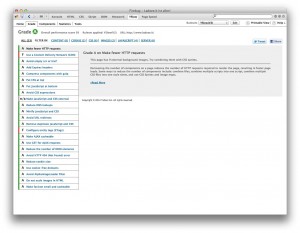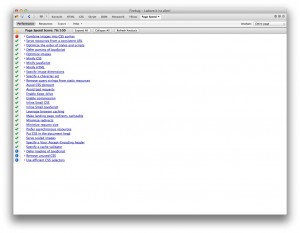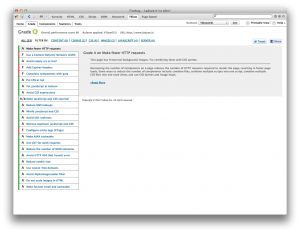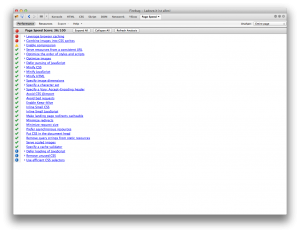36 von 100 möglichen Punkten erreicht ein frisch installierter xtcModified auf einem 1&1 Virtual Server. Diesen Wert gilt es jetzt im Rahmen dieser Artikelserie zu optimieren.
Browser-Caching nutzen
Ganz oben auf der Liste von Page Speed steht das fehlende Browser Caching.
Die Aktualität der folgenden Cache-fähigen Ressourcen ist nur von kurzer Dauer. Legen Sie fest, dass folgende Ressourcen künftig mindestens einmal pro Woche ablaufen:
Und darunter kommt so ziemlich jedes Bild, das Stylesheet und die Javascript-Dateien, die alle kein Ablaufdatum haben. Dieses würde festlegen, wie lange der Browser oder auch ein Proxyserver die Datei als aktuell betrachtet. Mit der aktuellen Konfiguration fordert er jede Datei bei jedem Aufruf erneut an, denn kein Ablaufdatum bedeutet, dass die Datei aus Browsersicht sofort veraltet ist.
Ein solches Verhalten ist sinnvoll und wünschenswert bei Inhalten, die bei jeder Anforderung die aktuellen Gegebenheiten reflektieren müssen, so führt beispielsweise das hinzufügen eines Artikels zum Warenkorb zu einer Änderung und das HTML für den Warenkorb darf dann eben nicht aus dem Cache geholt werden. Bilder, Stylesheets und Scripts ändern sich aber in der Regel nicht mit jedem Klick. Es ist also völlig unnötig, diese Dateien jedes Mal erneut anzufordern bzw. auch nur beim Server anzufragen, ob sich was geändert hat.
mod_expires for the rescue
Zwar gibt es in der .htaccess-Datei, die mit xtcModified mitkommt, einen Eintrag, um bestimmte Formate mit einem Ablaufdatum von einem Monat zu versehen (der aber standardmäßig nicht aktiv ist), ich bevorzuge hier aber die feiner aufgranulierte Lösung aus dem HTML5Boilerplate:
<IfModule mod_expires.c>
ExpiresActive on
# Perhaps better to whitelist expires rules? Perhaps.
ExpiresDefault "access plus 1 month"
# cache.appcache needs re-requests in FF 3.6 (thanks Remy ~Introducing HTML5)
ExpiresByType text/cache-manifest "access plus 0 seconds"
# Your document html
ExpiresByType text/html "access plus 0 seconds"
# Data
ExpiresByType text/xml "access plus 0 seconds"
ExpiresByType application/xml "access plus 0 seconds"
ExpiresByType application/json "access plus 0 seconds"
# Feed
ExpiresByType application/rss+xml "access plus 1 hour"
ExpiresByType application/atom+xml "access plus 1 hour"
# Favicon (cannot be renamed)
ExpiresByType image/x-icon "access plus 1 week"
# Media: images, video, audio
ExpiresByType image/gif "access plus 1 month"
ExpiresByType image/png "access plus 1 month"
ExpiresByType image/jpg "access plus 1 month"
ExpiresByType image/jpeg "access plus 1 month"
ExpiresByType video/ogg "access plus 1 month"
ExpiresByType audio/ogg "access plus 1 month"
ExpiresByType video/mp4 "access plus 1 month"
ExpiresByType video/webm "access plus 1 month"
# HTC files (css3pie)
ExpiresByType text/x-component "access plus 1 month"
# Webfonts
ExpiresByType font/truetype "access plus 1 month"
ExpiresByType font/opentype "access plus 1 month"
ExpiresByType application/x-font-woff "access plus 1 month"
ExpiresByType image/svg+xml "access plus 1 month"
ExpiresByType application/vnd.ms-fontobject "access plus 1 month"
# CSS and JavaScript
ExpiresByType text/css "access plus 1 year"
ExpiresByType application/javascript "access plus 1 year"
<IfModule mod_headers.c>
Header append Cache-Control "public"
</IfModule>
</IfModule> |
<IfModule mod_expires.c>
ExpiresActive on
# Perhaps better to whitelist expires rules? Perhaps.
ExpiresDefault "access plus 1 month"
# cache.appcache needs re-requests in FF 3.6 (thanks Remy ~Introducing HTML5)
ExpiresByType text/cache-manifest "access plus 0 seconds"
# Your document html
ExpiresByType text/html "access plus 0 seconds"
# Data
ExpiresByType text/xml "access plus 0 seconds"
ExpiresByType application/xml "access plus 0 seconds"
ExpiresByType application/json "access plus 0 seconds"
# Feed
ExpiresByType application/rss+xml "access plus 1 hour"
ExpiresByType application/atom+xml "access plus 1 hour"
# Favicon (cannot be renamed)
ExpiresByType image/x-icon "access plus 1 week"
# Media: images, video, audio
ExpiresByType image/gif "access plus 1 month"
ExpiresByType image/png "access plus 1 month"
ExpiresByType image/jpg "access plus 1 month"
ExpiresByType image/jpeg "access plus 1 month"
ExpiresByType video/ogg "access plus 1 month"
ExpiresByType audio/ogg "access plus 1 month"
ExpiresByType video/mp4 "access plus 1 month"
ExpiresByType video/webm "access plus 1 month"
# HTC files (css3pie)
ExpiresByType text/x-component "access plus 1 month"
# Webfonts
ExpiresByType font/truetype "access plus 1 month"
ExpiresByType font/opentype "access plus 1 month"
ExpiresByType application/x-font-woff "access plus 1 month"
ExpiresByType image/svg+xml "access plus 1 month"
ExpiresByType application/vnd.ms-fontobject "access plus 1 month"
# CSS and JavaScript
ExpiresByType text/css "access plus 1 year"
ExpiresByType application/javascript "access plus 1 year"
<IfModule mod_headers.c>
Header append Cache-Control "public"
</IfModule>
</IfModule>
Das ganze in If-Bedingungen zu verpacken verhindert effektiv Internal Server Errors (500), wenn das Modul nicht installiert ist. Klar, dass das ganze dann auch nichts bringt, aber ein Shop, der Inhalte ohne die Optimierung ausliefert ist immer noch besser als ein Shop, der nur eine Fehlermeldung zurückgibt.
Wenn aber mod_expires aktiv ist geschieht folgendes: Der generelle Wert für das Ablaufdatum wird auf einen Monat gesetzt und das ganze dann für Inhalte, die nicht gecached werden sollen, wieder zurückgesetzt. Anschließend werden die Werte für einzelnen Formate basierend auf dem MIME-Type gesetzt. Man könnte alles weglassen, was dem generellen Wert entspricht, aber ich lasse das hier mal mit aufgeführt, vielleicht will man den ein oder anderen Ablaufzeitraum doch anpassen, bei X-Skating sind es beispielsweise 10 Jahre für Bilder. Auf die dabei auftretenden Probleme gehe ich später noch ein.
Cache-Control “public” sorgt dann noch dafür, dass diese Inhalte auch von Proxies gecached werden können, auch wenn man sich vorher per HTTP authentifizieren musste (was für xtcModified aber nicht zutrifft).
Da mod_expires auf Grundlage der MIME-Types arbeitet empfiehlt es sich, noch einen anderen Bereich aus der Datei von HTML5Boilerplate zu übernehmen, nämlich den Teil, wo die MIME-Types vereinheitlicht werden, gerade Javascript kommt je nach Serverkonfiguration mit den obskursten MIME-Types daher:
# JavaScript
# Normalize to standard type (it's sniffed in IE anyways)
# tools.ietf.org/html/rfc4329#section-7.2
AddType application/javascript js
# Audio
AddType audio/ogg oga ogg
AddType audio/mp4 m4a
# Video
AddType video/ogg ogv
AddType video/mp4 mp4 m4v
AddType video/webm webm
# SVG
# Required for svg webfonts on iPad
# twitter.com/FontSquirrel/status/14855840545
AddType image/svg+xml svg svgz
AddEncoding gzip svgz
# Webfonts
AddType application/vnd.ms-fontobject eot
AddType application/x-font-ttf ttf ttc
AddType font/opentype otf
AddType application/x-font-woff woff
# Assorted types
AddType image/x-icon ico
AddType image/webp webp
AddType text/cache-manifest appcache manifest
AddType text/x-component htc
AddType application/x-chrome-extension crx
AddType application/x-opera-extension oex
AddType application/x-xpinstall xpi
AddType application/octet-stream safariextz
AddType application/x-web-app-manifest+json webapp
AddType text/x-vcard vcf |
# JavaScript
# Normalize to standard type (it's sniffed in IE anyways)
# tools.ietf.org/html/rfc4329#section-7.2
AddType application/javascript js
# Audio
AddType audio/ogg oga ogg
AddType audio/mp4 m4a
# Video
AddType video/ogg ogv
AddType video/mp4 mp4 m4v
AddType video/webm webm
# SVG
# Required for svg webfonts on iPad
# twitter.com/FontSquirrel/status/14855840545
AddType image/svg+xml svg svgz
AddEncoding gzip svgz
# Webfonts
AddType application/vnd.ms-fontobject eot
AddType application/x-font-ttf ttf ttc
AddType font/opentype otf
AddType application/x-font-woff woff
# Assorted types
AddType image/x-icon ico
AddType image/webp webp
AddType text/cache-manifest appcache manifest
AddType text/x-component htc
AddType application/x-chrome-extension crx
AddType application/x-opera-extension oex
AddType application/x-xpinstall xpi
AddType application/octet-stream safariextz
AddType application/x-web-app-manifest+json webapp
AddType text/x-vcard vcf
Die einzige Änderung, die wir noch an den Expires vornehmen ist das Favicon, das wird ebenfalls auf einen Monat gesetzt. Die .htaccess, wie sie bis zu diesem Zeitpunkt aussieht, kann hier heruntergeladen werden.
Erneut durch YSlow und Page Speed überprüft ergibt sich schon ein wesentlich besseres Bild. YSlow pendelt sich jetzt bei 89 Punkten ein, noch deutlicher ist die Steigerung bei Page Speed, 60 von 100 möglichen Punkten stehen jetzt bereits zu Buche.
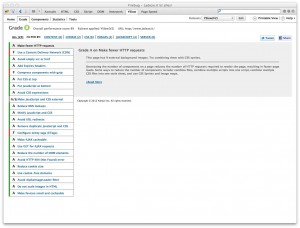
YSlow klettert von 80 auf 89 Punkte...
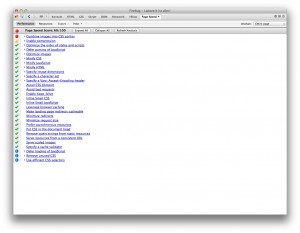
...Page Speed sogar von 36 auf 60
Auch schön zu sehen ist die extreme Reduktion an HTTP-Requests durch diese Maßnahme. So zeigt das Wasserfalldiagramm bei webpagetest.org ohne mod_expire auch bei der Anfragewiederholung noch alle Bilder etc. Der Server antwortet zwar mit 304 Not Modified, aber die Anfrage geht trotzdem raus und muss beantwortet werden. Sind Expire-Header gesetzt gehört das der Vergangenheit an.
Inhalte aktualisieren bei langen Expires
(Sehr) lange Expire-Zeiten bringen ein Problem mit sich: Da der Browser davon ausgeht, dass die CSS-Datei, die er gestern geladen hat, noch ein Jahr gültig ist, wird er erst gar nicht auf die Idee kommen, diese neu anzufordern. Daher kommt man um eine Versionierung nicht herum. HTML5Boilerplate empfiehlt das über Query-Paramter zu machen, statt stylesheet.css ruft man also beispielsweise stylesheet.css?20120112 auf. Damit man das nicht jedes Mal händisch aktualisieren muss sollte man die Zeilen 15 und 16 in templates/xtc5/css/general.css.php wie folgt ändern:
<link rel="stylesheet" href="<?php echo 'templates/'.CURRENT_TEMPLATE; ?>/stylesheet.css?<?php echo filemtime('templates/'.CURRENT_TEMPLATE.'/stylesheet.css') ?>" type="text/css" />
<link rel="stylesheet" href="<?php echo 'templates/'.CURRENT_TEMPLATE; ?>/css/thickbox.css?<?php echo filemtime('templates/'.CURRENT_TEMPLATE.'/css/thickbox.css') ?>" type="text/css" media="screen" /> |
<link rel="stylesheet" href="<?php echo 'templates/'.CURRENT_TEMPLATE; ?>/stylesheet.css?<?php echo filemtime('templates/'.CURRENT_TEMPLATE.'/stylesheet.css') ?>" type="text/css" />
<link rel="stylesheet" href="<?php echo 'templates/'.CURRENT_TEMPLATE; ?>/css/thickbox.css?<?php echo filemtime('templates/'.CURRENT_TEMPLATE.'/css/thickbox.css') ?>" type="text/css" media="screen" />
Damit wird immer das Datum der letzten Modifikation als Unix-Zeitstempel angehangen. Das gleiche sollte man auch für das Javascript machen, aber da wir uns dem eh im Rahmen dieser Serie noch gesondert annehmen müssen verschieben wir das auf einen späteren Zeitpunkt.
Als letztes Problemkind bleiben die Bilder. Die Lösung dafür ist etwas aufwendiger und wird behandelt werden wenn wir auf das Thema Content Delivery Networks (CDN) zu sprechen kommen.
Weitere Artikel der Serie
Disclaimer: Ich bin nach wie vor der Meinung, dass viele der Einstellungen in der Serverkonfiguration besser aufgehoben sind als in der .htaccess-Datei, da aber sicherlich viele das ganze auch auf Shared Hosting umsetzen möchten werden alle Änderungen, die auch über die .htaccess durchgeführt werden können, im Rahmen dieser Artikelreihe dort vorgenommen.
